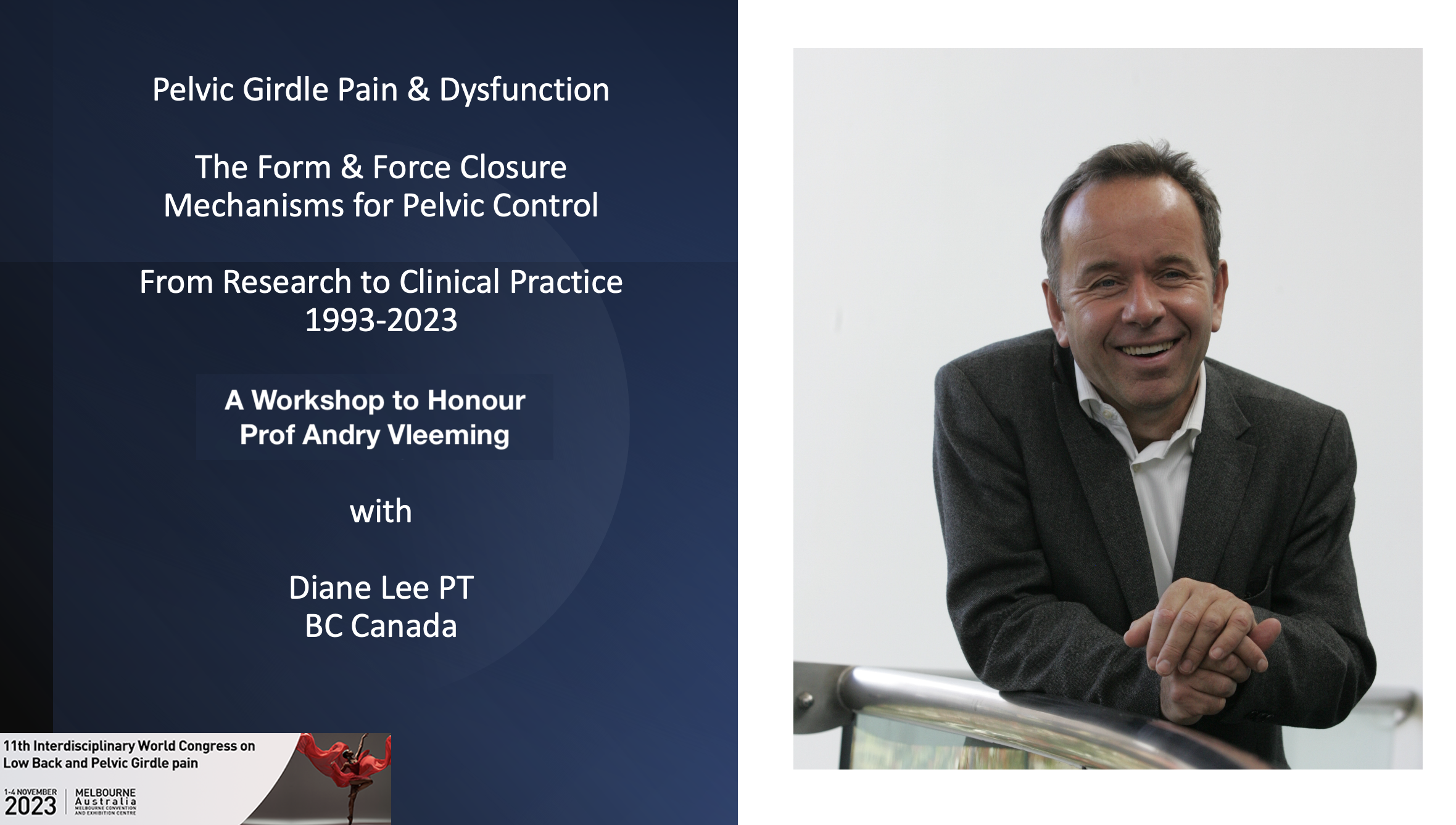Project Description
WORKSHOP 1:
Pelvic Girdle Pain & Dysfunction – The Form and Force Closure Mechanisms for Pelvic Control
30 Years of Research to Clinical Practice (1993-2023)
Speaker: Diane Lee PT

Description
The form and force closure mechanisms describing how loads are transferred through the pelvic girdle come from the pivotal research of Dr. Andry Vleeming, Dr. R Stoeckart, Professor Chris Snijders in the early 1990’s. These mechanisms provided evidence for the clinical tests of both passive and active control of the SIJ that were evolving in clinical practice concurrently (Diane Lee, Dr. Barb Hungerford).
Subsequently from the mid-90s to this present day, the understanding of how force closure of the pelvis can be impacted by motor control strategies, pain, trauma and certain emotional states, broadened our clinical assessment during which a true biopsychosocial model for managing pelvic girdle pain and dysfunction has evolved.
What remains to investigate, and is being considered today in clinical practice, is the impact remote impairments can have on these mechanisms of pelvic control. In other words, can clinicians reliably determine that the pelvic girdle is a victim of impairments elsewhere?
The pelvic girdle is part of the whole body/whole person and this workshop will focus primarily on the clinical application of the evidence to date (assessments of form and force closure mechanisms, motor control strategies and myofascial impairments (DRA)) after briefly describing a regional interdependent approach (the Integrated Systems Model (ISM)) that helps determine when to treat the pelvis and when to look elsewhere to improve strategies for effective load transfer.
9-10.30 Theory & Evidence
- The Beginning: 1990 – 1993 the research that led to the form and force closure mechanism models for pelvic control (Vleeming, Snjiders, Stoeckart)
- The Middle: 1995 – 2012 the research that improved our understanding of the force closure mechanism (motor control transversus abdominis, pelvic floor, sacral fibres of multifidus (Hodges, Sapsford, Hides & more) and led to the Integrated Model of Function (Lee & Vleeming) and ultimately recognition that pelvic girdle pain/dysfunction is not always caused by the pelvis (The Integrated Systems Model) (Lee 2011)
- The Present: 2012 – 2023 How understanding the phenotypes of pain, and the impact trauma and the emotional state in relationship to threat/safety has on pain and motor control, facilitates choice of approach to patient care (biomechanical & motor control (movement based) vs cognitive-behaviour approaches)
10:30 – 10:50 Morning tea
10:50 – 12:30 Knowledge Translation – From the Evidence to Clinical Practice (Part 1)
- The Integrated Systems Model – A Regional Interdependent Model to understand when the pelvis is a victim of impairments elsewhere (this workshop will only introduce this model via clinical videos)
- When the pelvis is the driver/problem (practical session):
- Further assessment of the Form Closure Mechanism – Active and Passive Mobility, Passive Control tests for the sacroiliac joint and pubic symphysis
- Further assessment of the Force Closure Mechanism – Active Control tests for the SIJ & pubic symphysis
12:30 – 1:30 Lunch Break
13:30 – 15:00 Knowledge Translation – From the Evidence to Clinical Practice (Part 2)
- Motor control analysis of the deep muscle system of the pelvic girdle (demonstration)
- Low fibres of transversus abdominis – clinical tests and ultrasound imaging
- ii).The pelvic floor – iliococcygeus & coccygeus – when to refer to a pelvic health physiotherapist
- ii).The sacral fibres of multifidus – clinical tests
- Diastasis Rectus Abdominis (DRA): Impact of a low DRA on the force closure mechanism of the pelvis – demonstrate clinical tests for myofascial integrity of the lowest part of the linea alba
15:00 – 15:20 Afternoon tea
15:20 – 16:30 Knowledge Translation – From the Evidence to Clinical Practice
- Clinical reasoning of clustered test findings (form & force closure and motor control tests) to guide individualized patient management
- Manual treatment techniques to release the restricted SIJ – demo or video
- Progressive stages of exercise training to restore motor control and the force closure mechanism – discussion


